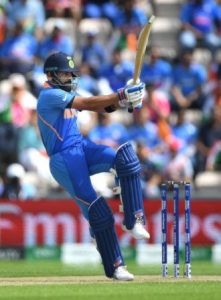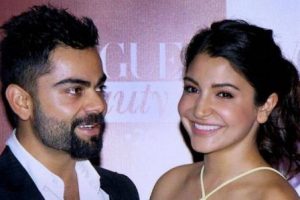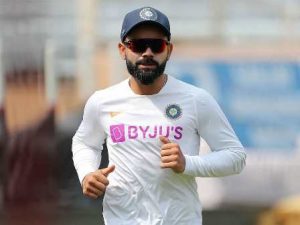Captain Kohli at 31: From Delhi Under-15 to Leading the Indian Team
As Virat Kohli steps into a new year of his life this 5th November, we take a look at his journey from his very own home ground in Delhi to leading India’s team in world cricket.

Today, at just 31, Virat Kohli is a name that stands strong as one of the best batsmen in the world. It is a name that is often associated with the pride of India and yet gives out a sense of familiarity with every Indian heart. Born to parents Prem Kohli and Saroj Kohli in Delhi, it was around the tender age of three when little Virat first took up the bat in his hands. His professional training began soon after, around the time when he was eight and by nine, he was enrolled in West Delhi Cricket Academy.
Kohli’s domestic career began with the 2002–03 Polly Umrigar Trophy where he was a part of the Delhi Under-15 team. He scored the highest in his team with 172 runs at an average of 34.40. The very next year he was appointed as the captain of the team for the same tournament. This marked the very birth of the leading spirit in Kohli unbeknownst of the fact that he would be leading the national team in world cricket a few years after. His scores remained considerably high with 390 runs in 5 innings at an average of 78. He also scored two centuries and two half-centuries.
It was in 2003–04 that he played the Vijay Merchant Trophy with Delhi Under-17 team. Despite heavy competition, he emerged out as the top scorer with 470 runs in just four matches at a remarkable average of 117.50 and an unbeaten 251 runs. The following year, Delhi emerged victorious in the Vijay Merchant Trophy and Kohli once again bagged the title of the top scorer with a tremendous 757 runs in seven matches with an average of 84.11. With back-to-back incredible deliveries, Virat already began turning heads and was selected to make his List A debut on a match against Services in 2006. However, he was not allowed to bat in the match. Needless to say, Virat’s batting prowess did not go unnoticed and on July 2006, he was made a part of India Under-19 tour of England and later, the tour of Pakistan. With a commendable average of 105 in the three-day ODI series and an average of 49 in the three-match Test series, irrespective of England’s difficult batting conditions and his own international debut, Kohli went on to impress many in the cricket world. Even for Pakistan, he maintained a good average of 41.66 in the ODI and 58 in the Test series.
On the same year, he was selected to play the Ranji Trophy and represented Delhi against Tamil Nadu in the first-class debut match. Unfortunately, before things could settle in, 18-year-old Kohli had to face the biggest loss of his life.
Also Read : Mary Koms Bronze Cornered Nikhat Zareens Delight
Amidst the match against Karnataka, when Delhi was 105/4 and Virat had to carry forward the follow-on next day with his unbeaten 40, his father passed away at just 54 years of age. An impeccably strong and determined Kohli came back to play the match and scored 90 runs.
Virat’s gesture, passion and love for the game left all his seniors, coaches, contemporaries and even opponents impressed. In 2007, he debuted in the Inter-State T20 Championship and became the highest scorer with 179 runs. Later in the Under-19s Tri-Series against SriLanka and Australia, he emerged as the second-highest run maker with 146 in 5 matches.
His breakthrough came in the form of the 2008 Under-19 Cricket World Cup in Malaysia where he headed the team as the captain. He became the third-highest scorer of the tournament and his captaincy led India towards winning the championship. This was also the tournament that gave him his very first man of the match award for his century in 74 balls against West Indies in the group stage. A second man of the match arrived at the semi-final where he scored 43 runs during the chase and took 2/27 against New Zealand.
In a very surprising selection, Virat was picked to be included in the Indian cricket team for India’s tour of Sri Lanka as well as the ICC Champions Trophy. By then, he was also bought by the Royal Challengers Bangalore for Indian Premiere League. Kohli’s first international ODI debut arrived as a provisional opener (both Sehwag and Tendulkar were injured at that point) at the mere age of 19 and he was dismissed at 12 in the first match. However, the fourth match had him scoring his first ODI half-century and a score of 54 runs that played an important role in making India win the series. Towards the end of the year, he had a chance to be a part of the Indian team but was not allowed to play.

The year 2009 did not open well for Kohli as he was dropped from the team before the five-match ODI against Sri Lanka. However, he continued giving some excellent deliveries in the Emerging Players Tournament throughout the year winning over the national selectors. It was this tournament that the man himself considers as the ‘turning point’ of his career. He once again returned to the national team for the Sri Lanka series as are placement for Gambhir, who was then injured.
The ICC Champions Trophy finally took place in 2009 and Kohli was batting at number 4. His first man of the match with the national team came with his undefeated 70 runs in a chase of 130 against West Indies in the same tournament. Post this, there was no looking back. Kohli was mostly at the top of his game and gave out remarkable performances in various ODIs. He also became the third-ever Indian batsman to score two ODI centuries before turning 22 against Sri Lanka and Bangladesh, respectively.
Kohli stepped into vice-captaincy of the Indian cricket team with Suresh Raina as the captain in the 2010 Tri-series against Sri Lanka and Zimbabwe. Despite India’s loss, it was during this series that Kohli was helmed as the fastest Indian batsman to score 1,000 runs in ODI cricket. Although he started struggling with his form, he was retained for the 2010 three-match series against Australia. He proved his mettle through the following series and became Indian’s top-scoring ODI batsmen in 2010 with 995 runs from 25 matches. Not only was his place in ODI cricket secured but he was also one of the strong contenders for 2011 World Cup.
In 2011, Kohli became a part of India’s playing eleven who lead the team towards victory in the World Cup.
In his first match against Bangladesh, Virat became the first Indian batsman to hit a century on his debut World Cup match.
Surprisingly, his form through the rest of the tournament remained low to average.

Virat debuted with Test cricket against West Indies at Kingston. Though he was initially dropped from the Test squad, he took up extreme training, practice and hard work. With further good performances in ODIs, he made a comeback and emerged as the highest run-scorer in 2011 with 1,381 runs from 34 matches. His Test performance improved leaps and bounds against Australia. Though India was whitewashed in the series, Kohli’s batting was appreciated. His delivery in the Commonwealth Triangular Series went on to establish him as one of the greatest knockers in ODIs. It was in the 2012 Asia Cup that he was appointed as the vice-captain of the team. This was followed by another set of brilliant ODI scores in 2013 ICC Champions Trophy which India won.
Kohli took over as the ODI captain for the very first time as a replacement of an injured Dhoni in the triangular series in West Indies. He also scored his first century as a captain in the same series. He was also appointed as the captain for an entire series in five-match ODI tour of Zimbabwe. After this, in the seven-match ODI against the Aussies, Virat hit the fastest century by an Indian player in history with just 52 balls. Post this series, Kohli achieved the numerouno position of ICC ODI batsmen rankings for the very first time.
The two-match series against West Indies in 2013 saw Virat becoming the fastest batsman to score 5,000 runs in ODI alongside Viv Richards. Kohli’s rule over the innings continued through several other matches and he was once again appointed the captain of New Zealand tour during Asia Cup in Dhoni’s absence. After Dhoni’s return in 2014 ICC World Twenty20, Kohli was named vice-captain of the team. In the same championship, he scored 319 runs at an average of 106.33 setting a record for maximum runs ever scored by a single batsman in World Twenty20 tournament. He was also declared to be the Man of the Tournament. In the five-match series against Sri Lanka the same year, Kohli became the first-ever batsman in the world to score beyond 6,000 runs in ODIs. He also became the second player in the world to score more than 1,000 runs in ODIs for four consecutive years after Ganguly. Towards the end of the year, he captained the team for a Test series for the first time against Australia. After Dhoni announced his retirement from Test cricket, Kohli was appointed as full-time Test match captain. Once again, he set a new record by being the first-ever batsman to score three centuries in three innings as Test captain.
India lost the World Cup in 2015 but Kohli received his first World Cup man of the match award by scoring 107 off 126 balls against Pakistan. Later that year, in the Sri Lankan tour, he had his first Test series win as a captain. In his 27th innings, Kohli also became the fastest batsman in the world to ever score a 1,000 runs in T20I cricket during South Africa’s India tour. India also moved up to the second position in ICC Test ranking under his captaincy.
Also Read : Want To Clock 50 78 Now Hima Das
In 2017, Kolhi captained the team for the first time in an ICC tournament with Champions Trophy. Under his captaincy, the team reached final but failed to win. However, Kohli once again became the fastest batsman to score 8,000 runs in ODIs in 175 innings. With few other matches and exemplary records, 2017 ended with Virat scoring 2,818 international runs, the highest tally by an Indian player of all time.
In 2018, Kohli became the first Indian captain who led the team towards victory in an ODI series in South Africa. Last year, he also became the No. 1 Test batsman according to ICC Test rankings. During the ODI series against West Indies, Kohli emerged as the fastest player in history to score 10,000 ODI runs. After India’s win against Australia in a series, he became the first-ever Indian and Asian captain to win a test series in Australia.
This year, Kohli was finally appointed as the captain of the Indian cricket team for 2019 ICC World Cup. Though India lost the semis, Kohli made a record of the fastest batsman to score 11,000 runs in ODI and the fastest cricketer to score 20,000 runs in international cricket in just 417th innings. Recently, he led Team India for the 50th time in Test cricket and also became the first-ever Indian batsman to score seven double centuries in Test cricket.
Virat Kohli’s journey is no less inspiring. It appears to be a very realistic roller-coaster ride, with a fair share of ups and downs and the highs and lows. His progression towards his immense success was gradual. He fell and he rose. He learned and he taught. He took one step at a time to achieve his dreams, goals, aspirations and continues to do the same. As he steps into another year in life, here’s hoping he continues to rule the cricket field like the ‘King’ Kohli that he is.
